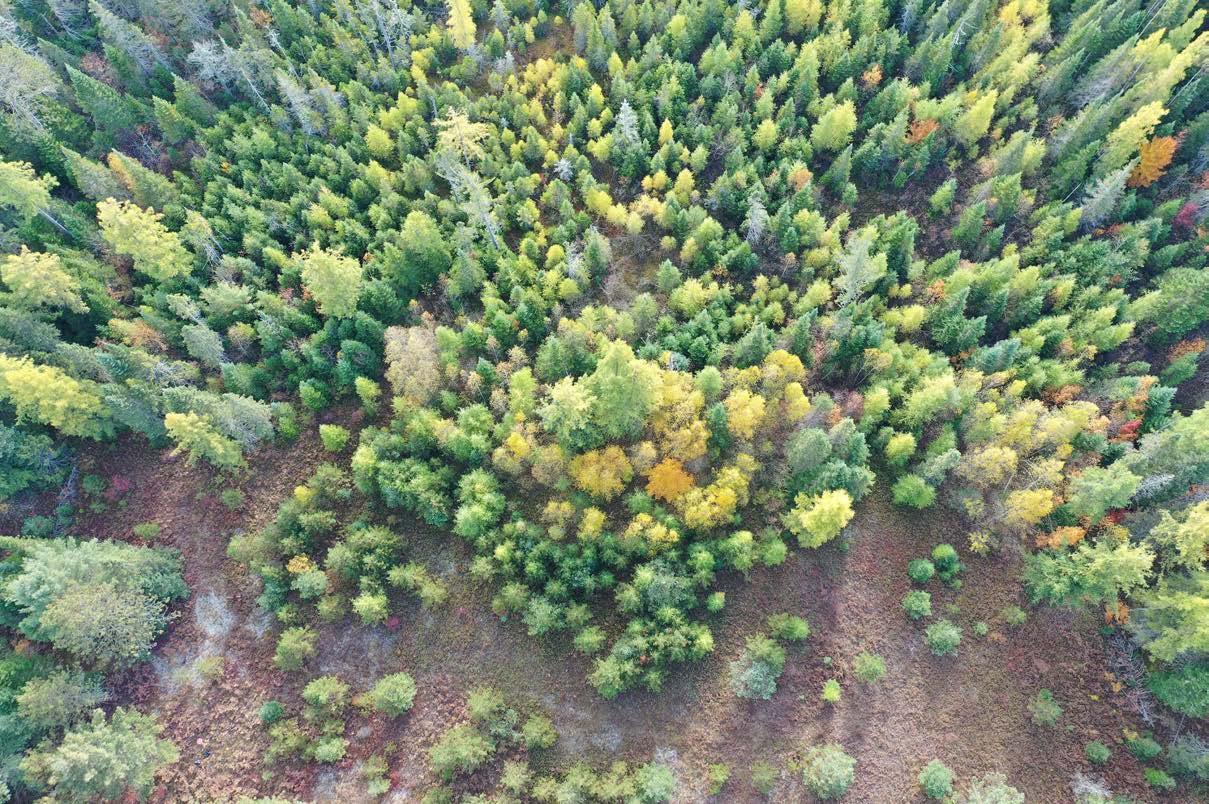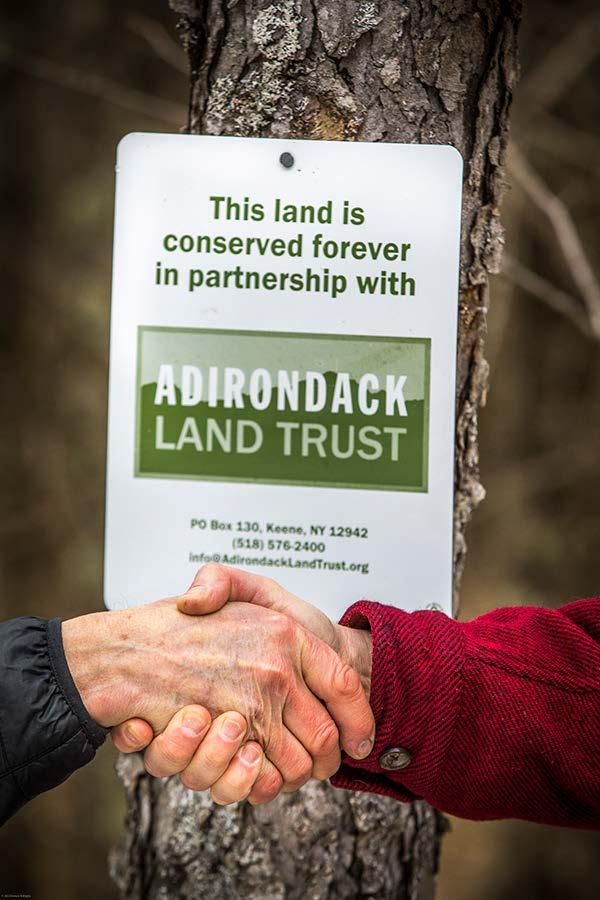Your Land, Your Legacy
A newsletter for Adirondack Land Trust conservation easement landowners

As the Adirondack Land Trust’s GIS (geographic information systems) expert, I always love a good map. Maps offer new perspectives and show context that is different from being on the ground. You can see how waterways flow across slopes, where different forest habitats are, how farmlands are arranged across the landscape, and what changes are taking place over time.
Maps, along with other tools, also provide an opportunity for us to work with you as a conservation easement landowner in new ways. The Adirondacks is a big region. Creating maps with satellite imagery and footage from unmanned aerial vehicles (UAVs, or drones) can add to the flexibility, thoroughness, and efficiency of our stewardship activities associated with the lands we protect in partnership with private landowners.

This kind of remote monitoring will never replace in-person property visits or the annual questions we need to ask, but it is a helpful tool in our conservation easement toolkit. We use a software program to access commercially available images, and, on the UAV side, I am currently the land trust’s only drone pilot. If you’re interested in seeing these images, getting an updated map of your property, or having us fly our UAV over your property, please let us know and we will arrange it.
We thank you for being a conservation easement landowner and hope you find this special newsletter of interest. Please do not hesitate to reach out to our staff with questions. We’d be happy to help you however we can.

 Becca Halter GIS & Stewardship Specialist
Becca Halter GIS & Stewardship Specialist
OUR MISSION is to forever conserve the forests, farmlands, water and wild places that advance the quality of life of our communities.

Spring 2023
2861 NYS Route 73, P.O. Box 130 Keene, NY 12942 | (518) 576-2400 | adirondacklandtrust.org
©AdkLandTrust/BeccaHalter
Q & A With Greg Fetters | Conservation Easement Landowner, Jay,
NY

What were the driving factors behind your desire to conserve your property through a conservation easement?
To prevent development, and as I grow older, I think more about it as a legacy. I grew up in the suburbs of Philadelphia, Pennsylvania and Wilmington, Delaware. It was always sad to see the fields and woodlots that I had played in developed into housing tracts and the back roads become dotted with new homes. That’s what drew me to the Adirondacks and the constitutional limits on development. A conservation easement was my way of doing something about it. I go for daily walks on my property rain or shine, snow or zero temps, and it is a joy to know this place I love will remain this way long after I am gone.
What wildlife are you seeing on your land?
I usually see a black bear, raccoon, porcupine, beaver, and a turtle once a year and a fisher about every other year. I have seen fox, otter, turkey, grouse, geese, ducks, heron, hawks and owls. AND a moose!
Are there any special programs that you've enrolled your lands in or management activities you'd like to share?
I have 100 acres enrolled in New York’s 480a program. This program reduces the assessed tax value by 80%. In the last 20 years I have had one timber harvest and donated 100% of the proceeds to the land trust’s stewardship fund. Periodic harvesting improves the quality of the forest and maintains wildlife habitat.
My home is heated with a combination of passive solar and wood. Every year I harvest about four cords of firewood. I spend every weekend in the late fall cutting and hauling wood and find that this process really connects me to the land.
Every other year I mow a 10-acre clearing in the late fall after the monarchs leave to allow the wildflowers and grasses to grow for the pollinators and wildlife. I have thought about putting up duck boxes around the wetlands, and maybe now that I am retired, I may actually do it.
Your Land, Your Legacy Spring 2023 Page 2
GregFetters(center)isamongtheprivatelandownerswithwhomweworktoprotect61propertiescoveringnearly20,000acresthroughoutthe Adirondacks. HeispicturedherewithstewardshipmanagerDerekRogers(left)andconservationprogramdirectorChrisJage(right).
© Nancie Battaglia
.
Stew Crew, Here for You
Landowners make conservation choices all the time, and one of our roles is simply advisory—to help you make informed decisions. If we don’t have an answer to a specific question, chances are we can steer you to someone who does. Please call on us.


Stewardship & GIS Specialist becca.halter@adirondacklandtrust.org (518) 576-2400 x105
Conservation Program Director chris.jage@adirondacklandtrust.org (518) 576-2400 x111
Signs Available



Stewardship Manager derek.rogers@adirondacklandtrust.org (518) 576-2400 x114

.
Farmland & Stewardship Specialist aaron.thomas@adirondacklandtrust.org (518) 576-2400 x106

If you are interested in signs for your property, please let us know. Along a trail, at a farm store, or in any well-chosen spot, these aluminum signs can help build awareness about conservation partnerships. They are free of charge and available in the following sizes: 3.75" diamond or 9"x12" rectangle.
What Does it Mean to Be Accredited?
.
The Adirondack Land Trust was accredited in 2019. We are proud to include this accreditation seal - a mark of distinction - on our materials and our website. It is our promise to you that we hold ourselves accountable to the highest national standards of excellence and conservation permanence.
Each accredited land trust completes a rigorous review process and joins a network of organizations united by strong ethical practices. This network of land trusts demonstrates fiscal accountability, strong organizational leadership, sound transactions and lasting stewardship of the lands they conserve.
Spring 2023 Your Land, Your Legacy Spring 2023
Page 3
Becca Halter
Chris Jage
Derek Rogers
Aaron Thomas
©NancieBattaglia
Staff
images © Lisa Godfrey
Landowner Resources
We get it: sifting through available tools and workshops to help with landowner management and planning can be a challenge. We did some sifting for you, keeping in mind which opportunities may be most applicable to you, our conservation easement partners in the Adirondack region.
AdkAction Pollinator-Friendly Native Plant Sale
Looking for carefully sourced native plants to improve wildlife and pollinator habitat, while simultaneously beautifying your property? Look no further than this native plant sale. All proceeds directly benefit AdkAction’s Pollinator Project. See adkaction.org/project/adirondackpollinator-project
Farmland Planning Assistance
Up to $500 is available for farmers in Essex County for farm succession planning help. Funds cover one-on-one consultations with experts in estate planning, tax planning and related fields. Contact Megan Zack Stevenson, our land protection manager, megan.stevenson@ adirondacklandtrust.org or (518) 576-2400 x109.
Financial Assistance for Hayfield Management
The Bobolink Project provides financial assistance to participating farmers who modify their mowing schedules so that grassland nesting birds can successfully raise their young. The program is administered by Mass Audubon, Audubon Vermont, and New Hampshire Audubon. See bobolinkproject.com
Stopping Invasive Species
Love the eastern hemlocks that shade your streams? Concerned about what the jumping worm might do to your soils and plants? The Nature Conservancy’s Adirondack Park Invasive Plant Program offers best management practices, webinars and other resources. See adkinvasives.com
Trees
for Tribs
NYSDEC’s annual Buffer in a Bag Program is open for applications this year until April 11. Landowners can receive a bag of 25 free tree and shrub seedlings for planting near streams and lakes to stabilize banks, protect water quality and improve wildlife habitat. See dec.ny.gov/animals/77710.html #Bag
NYS Tax Credits for Your Easement
You might be eligible for a refundable state income tax credit for having a conservation easement on your land.
If you meet the following criteria, you might save 25% on your school, county, and town property taxes:
The easement was donated or sold for less than full value
The easement is permanent and held by a public or private conservation group
The easement has a Department of Environmental Conservation conservation easement identification number (We can help you get this!)

The land under easement is owned by individuals or a business (except for S corporations)
To learn more, scan this QR code, search online “NYS Conservation Easement Tax Credit,” or call Chris Jage (518) 576-2400 x111.


Spring 2023 Your Land, Your Legacy Spring 2023
Page 4
©LarryMaster



 Becca Halter GIS & Stewardship Specialist
Becca Halter GIS & Stewardship Specialist










